 As you all know, we here at "The Other View" are about media and the tech that surrounds it. Movies, animation, video games, and all the lovely hardware that makes it all happen, is what we love. With that said, let's talk about one of my favorite media tech topics; the HTPC. For the uninitiated, HTPC stands for Home Theater Personal Computer and I'm sure that if you're reading this, you've heard the term at least once in the past few months in relation to all manner of set top boxes that have been released in rapid succession - from Apple TV2 to Boxee to Google TV and everything in between. What they're all missing is the ability to provide a full blown desktop experience from a couch and that's where the HTPC comes in.
As you all know, we here at "The Other View" are about media and the tech that surrounds it. Movies, animation, video games, and all the lovely hardware that makes it all happen, is what we love. With that said, let's talk about one of my favorite media tech topics; the HTPC. For the uninitiated, HTPC stands for Home Theater Personal Computer and I'm sure that if you're reading this, you've heard the term at least once in the past few months in relation to all manner of set top boxes that have been released in rapid succession - from Apple TV2 to Boxee to Google TV and everything in between. What they're all missing is the ability to provide a full blown desktop experience from a couch and that's where the HTPC comes in.
Today we have Zotac's newest take on the HTPC, the ZBox AD02 Plus. This very small computer is based completely on AMD products. You can get a run down of what's inside in my unboxing video below.
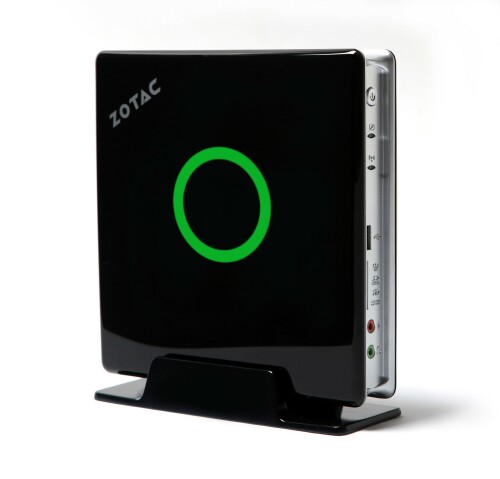
Incase you didn't catch the specs, the ZBox AD02 is running AMD's new Vision APU, specifically the E-350 which is a dual core cpu rated at 1.6ghz. Also inside is ATI's Radeon 6310 HD graphics processor. The Plus means that instead of being a barebones kit that you still have to buy RAM and a hard drive, those things come pre-installed. All you need to provide are input devices and an OS. This system came with 2GB of DDR3 RAM and a Samsung 250gb hard drive. Not too shabby.
Taking a look around the outside, you'll notice a good amount of ports, lights, and general stuff along the silver edges. The AD02 has the following ports:
- 4x USB 2.0
- 2x USB 3.0
- eSATA
- VGA output (via adapter)
- HDMI output
- DVI output
- Gigabit Ethernet
- S/PDIF
- Memory card slot (SD, SDHC, MMC, MS, MS Pro, xD)
- Mic/Headphone ports
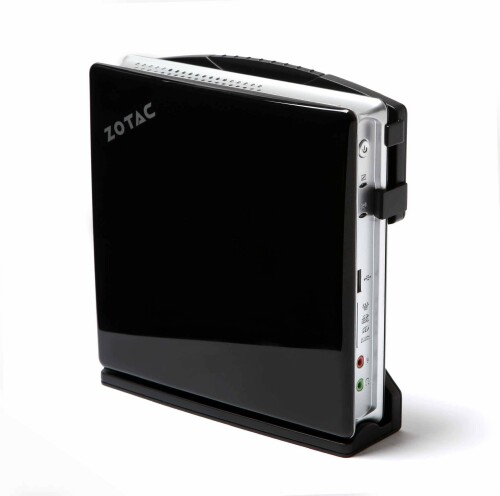
That's a lot considering it's all placed on to a system that's not much bigger than about 3 DVD cases. It also can be put to lie down or stand vertically. The stand is very solid and doesn't let the AD02 wobble at all. Also included is a VESA dock/mount for the computer. This allows you to mount the entire computer to the back of a monitor, completely hiding it. I will say that the AD02 isn't meant for stacking unless it's going to be on top. The 2 black outer walls (the top and bottom if it's laid on its side) are slightly convex and don't let much sit firmly on top.
Let's take a look at how it handles.
For my testing I not only ran it through Passmark's Performance Test 7.0, but also did real world testing with Windows 7 Home Premium 64bit, Windows 7 Media Center, XBMC, Boxee, and Hulu Desktop. I also tested it with 3 different hard drives, the one that it comes with, our Samsung MZ-5PA128/US SSD, and our Intel X25-M 80GB SSD.
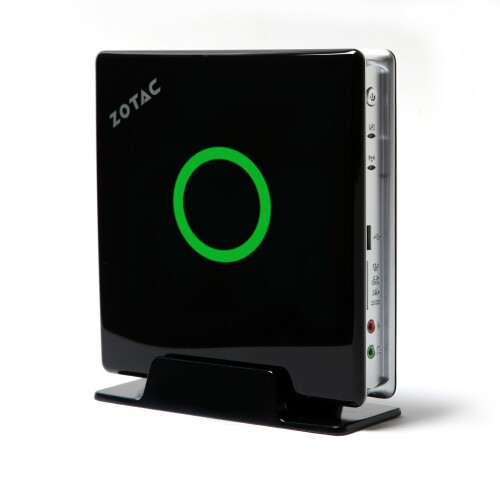
Getting the OS on the AD02 was interesting. Using our Lite-On eNAU608 Slim External DVD Drive posed some problems. Certain generic USB cables worked while others wouldn't allow the drive to be recognized. Or worse, I was getting an error during the beginning of the Windows install that said optical disc drivers were required to continue. I was very confused. I ended up using another USB drive with our Lite-On drive the first time. What I realized after is that the USB 3.0 ports weren't backwards compatible before the drivers were installed into an OS. I had plugged the disc drive into a USB 3.0 port because the 2 USB 2.0 ports were occupied by the mouse and keyboard I was using. Plugging into either the top or front usb 2.0 ports solved this issue.
Boot times for Windows 7 were sluggish. The mechanical Samsung 250gb hard drive (5400 rpm with an 8mb cache) was painfully slow to boot from being completely off. We're talking minutes to get into Windows and there were times that I thought it had frozen. Booting from sleep or even hibernation was very quick though. Neither of the SSD's were incredibly fast to boot either. Granted, they weren't anywhere near as slow as the mechanical drive, but it wasn't like you could push the power button, click your heels together, and Windows would be ready to work.

Installing XBMC Live was easy as pie. I tested it on the Intel SSD and it couldn't have gone smoother. Unfortunately, once in XBMC, the computer was useless. Menus lagged so hard that the entire system wouldn't work. I don't know enough CMD line to diagnose what was really happening, but I did notice something weird in the system profile. In there I saw that XBMC was bringing the load of one of the 2 cores in to the 90+ percent range and the other one was near idle. The loads would then jump from one core to another. So XBMC Live was FAIL.
XBMC in Windows however was a dream. Since I already use XBMC on my Acer Revo, all of my files are organized and named for it and scraping my library went very smoothly. If you do want to use XBMC in Windows with HDMI carrying audio and video, make sure to do a few things before settling in to watch anything. First in the video settings, make sure to enable "allow use of hardware for video acceleration" or something to that effect. This will make the computer use the graphics card to help push HD content. Also switch audio out to HDMI and uncheck "use Dolby capable receiver" and "use DTS capable receiver" if you don't have them.

Windows 7 Media Center (WMC) was also very impressive. Everything worked flawlessly, at least everything that was supposed to work. I still find WMC unintuitive for setting up file locations to scrape and its inability to recognize/play certain video formats is infuriating. But that's a discussion for another day. WMC works well and streaming wasn't a problem. Even HD content, streamed and local, looked great.
Boxee also worked great and was dead simple to install. Setting up Boxee was even less intuitive than WMC, as I couldn't figure out for the life of me how to add specific folders to my sources. The rest of Boxee worked fine though. Streaming was clean and crisp and the interface, while not my favorite, was snappy enough and responsive.
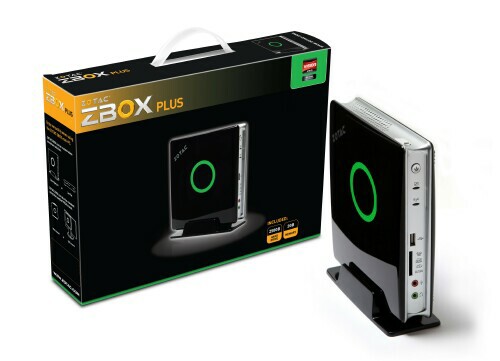
Lastly, out of all the media center solutions I tried Hulu Desktop and results similar to Boxee. It worked fine and video streamed like no one's business. There were no settings to mess with or adjust. It was just fire it up, log in, and start watching.
Working in Windows 7 was a dream once you got in. the internet wasn't laggy at all, with YouTube and Flash in general working beautifully. Doing a bit of file transferring and renaming was just as flawless. I could easily see this computer being used as very small family desktop. With such a small footprint, especially when stood upright, all you would need is to add an external data drive and everyone could use it.
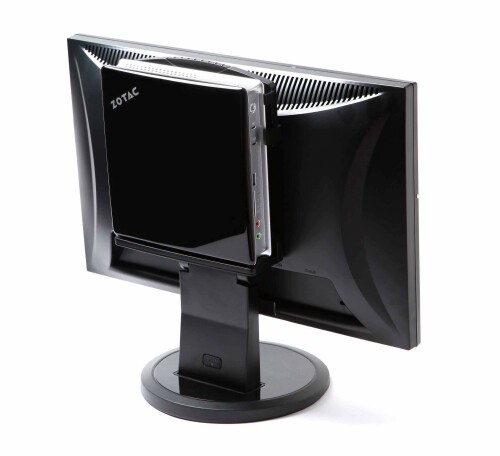
Within Performance Test 7, the ZBox AD02 scored a 416 and a 430 with our DVD drive attached. It excelled at more complex tasks rather than simple tasks, the gpu was much better at 3D than 2D, and was generally better than the Acer Aspire Revo 1600 benchmark I was comparing it to. If you want to compare it to your Windows based HTPC, you can search for my base line test with the search term "zotac ad02" and you'll find it.
Overall this Zotac ZBox AD02 is a great little system. It'll handle your HTPC needs without a hiccup and can even be used as a daily computer as long as you're not doing anything super intensive. I cannot recommend, however, the Plus over the barebones kit. The barebones kit doesn't come with a hard drive or RAM, but for the $90 difference between the two you can get more RAM and larger capacity hard drive. The Plus comes in at $339.99 on Newegg and the Barebones kit at $249.99. With that all said and done, I'm giving the Zotac ZBox AD02 Plus a 3.5 and the Barebones kit a 4.5 out of 5 TOV stars.

